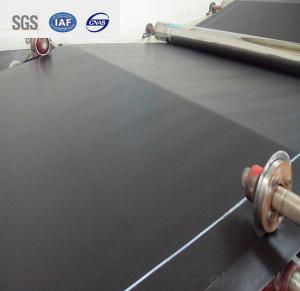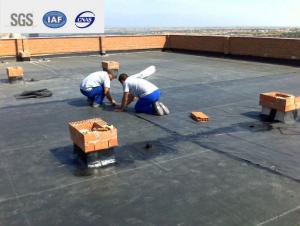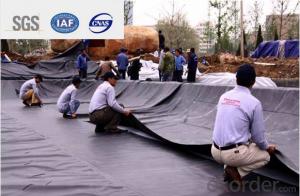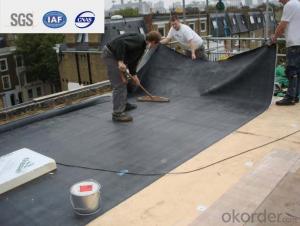EPDM Self-adhesive Waterproof Membrane for Rooftop1.2mm
- Loading Port:
- Qingdao
- Payment Terms:
- TT OR LC
- Min Order Qty:
- 2000 m²
- Supply Capability:
- 800000 m²/month
OKorder Service Pledge
OKorder Financial Service
You Might Also Like
Description Of EPDM Rubber Waterproof Membrane:
1. EPDM waterproof membrane is made from ternary ethylene-propylene rubber, which is for waterproofing of exposed and non-exposed applications.
2. EPDM waterproof membrane production adopts the world-advanced equipment of cold feeding extrusion and continuous vulcanization technology.
3. EPDM waterproof membrane is of high elasticity among high polymer waterproof materials and becomes a world-popular waterproofing material.
Main Features of EPDM Rubber Waterproof Membrane:
1. Excellent physical and mechanical performance
2. High tearing resistance
3. Good deformation adaptability
4. High puncture resistance
5. High aging resistance
6. UV resistance
Specifications of EPDM Rubber Waterproof Membrane:
Material | EPDM Rubber |
Size | 1.2m (width)*20m (length) or customized, weldable type 2.05m or 4m width |
Thick | 1.2mm, 1.5mm, 2.0mm |
Type | Vulcanized & Weldable |
Pattern | Non-reinforced (homogeneous) |
Certificate | ISO9001/14001 |
Applications of EPDM Rubber Waterproof Membrane:
1.Roofs, Basement, Toilets
2. Industrial and civil building waterproofing
3. Geosynthetic liner for swimming pool, channels, irrigation system
4. Especially suitable for projects with high requirements in durability, anti-corrosion and deformation.
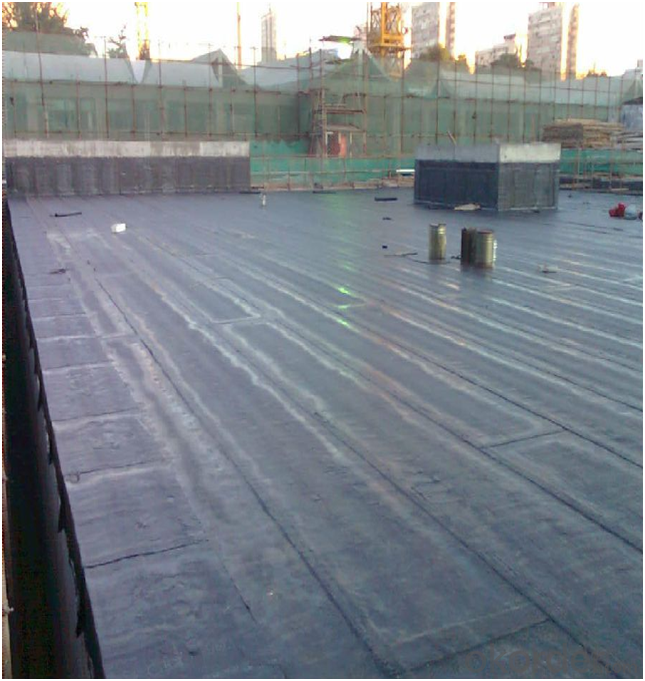


FAQ:
1. What are we supplying?
We are specialized in producing Colorful Asphalt Roof Shingle, SBS/APP modified bitumen waterproof membrane, Self adhesive bitumen waterproof membrane, PVC waterproofing membrane, EPDM rubber roofing membrane, Single Component Polyurethane Waterproof Coating, and Spray Polyurea Waterproof Coating.
2. How Many years experience do we have?
We have been exported to more than 20 countries in the past 15 years.
3. How long do we usually reply your request?
We always reply our customer within 24 hours.
- Q:Can a waterproofing membrane be applied on both horizontal and vertical surfaces?
- Waterproofing membranes can be utilized on surfaces that are both horizontal and vertical. These membranes are designed to form a barrier that prevents water from penetrating and causing harm to said surfaces. They find common use in various areas such as roofs, basements, bathrooms, and swimming pools. Whether it be a floor or a wall, the waterproofing membrane can be applied to safeguard against water infiltration. The application process may differ depending on the specific surface, but there are membranes readily available that can be easily applied to both horizontal and vertical surfaces. To guarantee proper installation and effectiveness of the waterproofing membrane, it is vital to adhere to the manufacturer's instructions and seek guidance from professionals.
- Q:Can waterproofing membranes be used on wood surfaces?
- Yes, waterproofing membranes can be used on wood surfaces. Waterproofing membranes are versatile and can be applied to various materials, including wood. They provide a protective barrier that prevents water from penetrating the wood, helping to prolong its lifespan and prevent damage caused by moisture.
- Q:Are waterproofing membranes resistant to high temperatures?
- Waterproofing membranes can vary in their resistance to high temperatures depending on the specific material used. Some waterproofing membranes are designed to withstand high temperatures without losing their effectiveness or integrity. These membranes are often made from materials such as modified bitumen or synthetic rubber, which have high temperature resistance properties. However, it is important to note that not all waterproofing membranes are resistant to high temperatures. Some membranes made from PVC or other thermoplastic materials may have limitations when exposed to extreme heat. Therefore, it is crucial to consult the manufacturer's specifications and guidelines to ensure that the chosen waterproofing membrane is suitable for the intended application and can withstand the anticipated temperature conditions.
- Q:Can a waterproofing membrane be applied over cracks or joints in a surface?
- Yes, a waterproofing membrane can be applied over cracks or joints in a surface. In fact, it is often recommended to do so in order to ensure a complete and effective waterproofing system. The membrane acts as a barrier that prevents water from seeping through the cracks or joints and causing damage to the underlying structure. However, it is important to note that the cracks or joints should be properly repaired and prepared before applying the waterproofing membrane. This may involve cleaning, filling, and sealing the cracks or joints to ensure that the membrane adheres properly and provides a continuous and watertight seal. Additionally, the type of waterproofing membrane used should be selected based on the specific requirements and conditions of the surface being treated.
- Q:Can a waterproofing membrane be used on foam block surfaces?
- Yes, a waterproofing membrane can be used on foam block surfaces. Foam blocks, such as expanded polystyrene (EPS) or extruded polystyrene (XPS), are often used as insulation in buildings. However, foam blocks are not inherently waterproof and can absorb moisture if left unprotected. To prevent water infiltration and potential damage, a waterproofing membrane can be applied to the foam block surfaces. The membrane acts as a barrier, preventing water from seeping into the foam and protecting it from moisture-related issues such as mold, mildew, or degradation. It is important to select a waterproofing membrane that is compatible with foam block surfaces and follow the manufacturer's instructions for proper application. Additionally, it is recommended to consult with a professional or a building engineer to ensure the appropriate waterproofing solution is chosen for the specific foam block application.
- Q:Can waterproofing membranes be used on expansion joints?
- Indeed, expansion joints can benefit from the utilization of waterproofing membranes. These joints serve the purpose of accommodating movement while safeguarding against harm brought about by the expansion or contraction of construction materials due to thermal fluctuations. By applying waterproofing membranes to these joints, a protective barrier is established, effectively impeding the infiltration of water. This serves to preserve the joint's structural integrity and prevent water-induced damage to adjacent areas. It is imperative to carefully select a flexible waterproofing membrane that can endure the joint's movements without incurring cracks or deterioration. Furthermore, the employment of proper installation techniques is crucial to ensuring a watertight seal around the expansion joint.
- Q:Can a waterproofing membrane be used on stainless steel surfaces?
- Yes, a waterproofing membrane can be used on stainless steel surfaces. Stainless steel is a durable and non-corrosive material that is commonly used in various industries. However, it is not completely immune to water damage or corrosion, especially in harsh environments. Applying a waterproofing membrane on stainless steel surfaces can provide an additional layer of protection against moisture, preventing potential water damage, rusting, and corrosion. It is important to ensure that the waterproofing membrane is compatible with stainless steel and applied correctly to ensure proper adhesion and long-lasting protection.
- Q:Are waterproofing membranes resistant to hydrocarbons?
- Yes, waterproofing membranes are generally resistant to hydrocarbons. They are designed to provide a barrier against water and other liquids, including hydrocarbons, preventing them from penetrating through the membrane and causing damage to the underlying structure.
- Q:Can a waterproofing membrane be covered or concealed by other finishes or materials?
- Indeed, other finishes or materials have the capability to cover or mask a waterproofing membrane. In fact, this practice is widely employed in construction projects. The primary purpose of a waterproofing membrane is to establish a barrier against water infiltration and safeguard the underlying structure. Prior to the application of other finishes or materials, it is typically installed on surfaces like roofs, foundations, or walls. Concealing the waterproofing membrane with other finishes or materials serves two key objectives. Firstly, it enhances the aesthetics of the structure. Whether it is a roof, bathroom, or basement, hiding the waterproofing membrane allows for the incorporation of more visually pleasing finishes such as tiles, paints, or decorative elements. Secondly, covering the waterproofing membrane provides an additional layer of protection. While the membrane itself is designed to be water-resistant, it may still be susceptible to damage from UV rays, foot traffic, or general wear and tear. By adding other finishes or materials on top, such as protective coatings, tiles, or concrete, the waterproofing membrane is shielded from potential harm, extending its lifespan and effectiveness. However, it is crucial to note that proper installation and compatibility between the waterproofing membrane and the covering materials are of utmost importance. The covering materials should not compromise the integrity of the membrane or create any weak points. Additionally, any penetrations or joints in the covering materials must be meticulously sealed to maintain the effectiveness of the waterproofing system. Therefore, while it is possible to cover or conceal a waterproofing membrane with other finishes or materials, it is essential to adhere to manufacturer guidelines and seek professional advice to ensure the overall integrity and performance of the waterproofing system.
- Q:Can a waterproofing membrane be used in tunnels?
- Yes, a waterproofing membrane can be used in tunnels. Waterproofing membranes are commonly used in tunnel construction to prevent water infiltration and protect the tunnel structure from damage caused by moisture. These membranes are designed to provide a barrier against water, keeping the tunnel dry and secure.
1. Manufacturer Overview |
|
|---|---|
| Location | |
| Year Established | |
| Annual Output Value | |
| Main Markets | |
| Company Certifications | |
2. Manufacturer Certificates |
|
|---|---|
| a) Certification Name | |
| Range | |
| Reference | |
| Validity Period | |
3. Manufacturer Capability |
|
|---|---|
| a)Trade Capacity | |
| Nearest Port | |
| Export Percentage | |
| No.of Employees in Trade Department | |
| Language Spoken: | |
| b)Factory Information | |
| Factory Size: | |
| No. of Production Lines | |
| Contract Manufacturing | |
| Product Price Range | |
Send your message to us
EPDM Self-adhesive Waterproof Membrane for Rooftop1.2mm
- Loading Port:
- Qingdao
- Payment Terms:
- TT OR LC
- Min Order Qty:
- 2000 m²
- Supply Capability:
- 800000 m²/month
OKorder Service Pledge
OKorder Financial Service
Similar products
New products
Hot products
Related keywords


